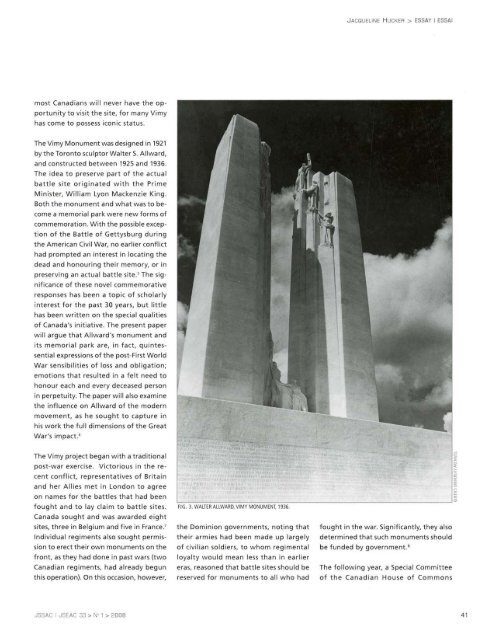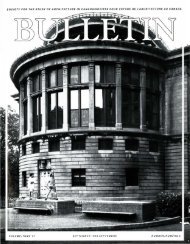CANADA - SEXTONdigital
CANADA - SEXTONdigital
CANADA - SEXTONdigital
You also want an ePaper? Increase the reach of your titles
YUMPU automatically turns print PDFs into web optimized ePapers that Google loves.
J ACQUELINE H UCKER > ESSAY I ESSAI<br />
most Canadians w ill never ha ve the opportunity<br />
to visit the site, for many Vi my<br />
has come to possess iconic status.<br />
The Vi my Monument w as designed in 1921<br />
by the Toronto sculptor WalterS. Allward,<br />
and constructed betw een 1925 and 1936.<br />
The idea to preserve part of the actual<br />
battle site originated w ith the Prime<br />
Minister, William Lyon Mackenzie King.<br />
Both the monument and w hat was to become<br />
a memorial park w ere new forms of<br />
commemoration. With the possible exception<br />
of the Battle of Gettysburg during<br />
the American Civil War, no earlier conflict<br />
had prompted an interest in locating the<br />
dead and honouring their memory, or in<br />
preserving an actual battle site.' The significance<br />
of these novel commemorative<br />
responses has been a topic of scholarly<br />
interest for the past 30 years, but little<br />
has been written on the special qualities<br />
of Canada 's in it iative. The present paper<br />
w ill argue that Allw ard's monument and<br />
its memorial park are, in fact, quintessential<br />
expressions of the post-First World<br />
War sensibilities of loss and obligation;<br />
emotions that resulted in a f elt need to<br />
honour each and every deceased person<br />
in perpetuity. The paper will also examine<br />
the influence on Allward of the modern<br />
movement, as he sought to capture in<br />
his work the full dimensions of the Great<br />
War's impact. 6<br />
The Vi my project began with a traditional<br />
post-war exerci se . Victorious in the re <br />
cent conflict, representatives of Britain<br />
and her Allies met in London to agree<br />
on names for the battles that had been<br />
fought and to lay claim to battle sites.<br />
Canada sought and was awarded eight<br />
sites, three in Be lgium and five in France. 7<br />
Individual regiments also sought permission<br />
to erect their own monuments on the<br />
front, as they had done in past wars (tw o<br />
Canadian reg iments, had already begun<br />
this operation). On this occasion, however,<br />
FIG . 3. WALTER ALL WARD, VI MY MONUMENT. 1936.<br />
the Dominion governments, noting that<br />
their armies had been made up largely<br />
of civilian soldiers, to whom regimental<br />
loyalty w ould mean less than in ea rlier<br />
eras, reasoned that battle sites should be<br />
reserved for monuments to all who had<br />
fought in the w ar. Significantly, they also<br />
determined that such monuments should<br />
be funded by government. 8<br />
The following year, a Speci al Committee<br />
of the Canadian House of Commons<br />
JSSAC I JSEAC 33 > N" 1 > 2008<br />
41
















